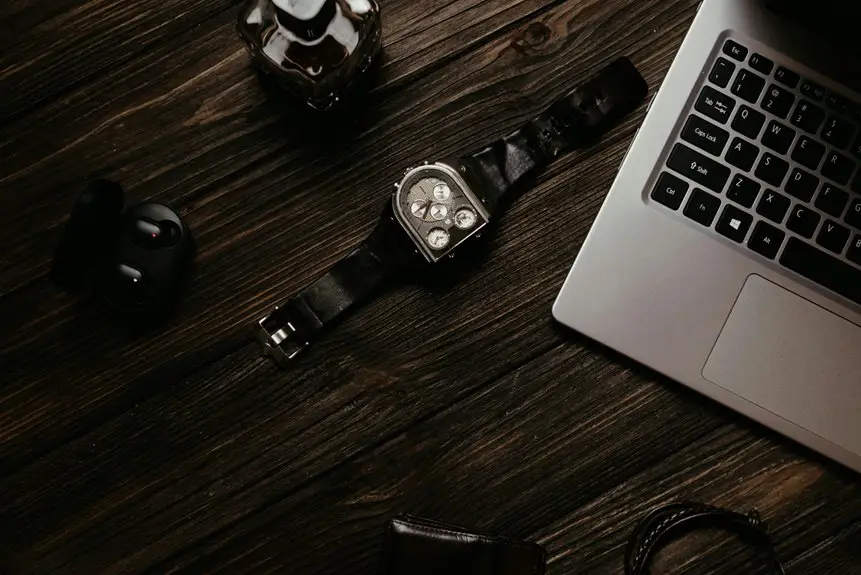To route cables behind your desk, start by assessing your cable needs and planning an organized route. Gather necessary tools like cable clips, sleeves, and scissors. Use cable management solutions to group and secure cables, avoiding clutter. Consider cable covers to hide unsightly cords and enhance your workspace's aesthetics. Regularly maintain your setup to prevent tangles and hazards. You'll want to keep things tidy and efficient, so keep going to discover more tips!
Table of Contents
Key Takeaways
- Identify all devices and their required connections to determine the necessary cable types and lengths for an organized setup.
- Plan cable routes along walls or under the desk, avoiding crossings to maintain a tidy appearance and prevent tangling.
- Use cable management solutions like clips, sleeves, and raceways to secure and conceal cables effectively behind your desk.
- Label cables and ties for easy identification, ensuring a streamlined setup that simplifies adjustments and maintenance.
- Regularly inspect and maintain cables to prevent wear, minimize hazards, and ensure a safe and organized workspace.
Assess Your Cable Needs
How can you effectively determine your cable needs? Start by identifying all the devices you'll connect to your desk setup. Consider your computer, monitor, printer, and any peripherals like speakers or a webcam.
Next, take note of the types of connections each device requires—USB, HDMI, Ethernet, or power cables. Don't forget about the length of each cable; you want them long enough to reach their respective ports but not so long that they create clutter.
Think about how you'll manage these cables—will they run along the wall, under the desk, or through a cable management system? By listing your devices and their requirements, you'll gain clarity on what cables you need, ensuring a tidy and functional workspace.
Gather Your Tools and Materials
Before you start routing your cables, you'll need to gather some essential tools and materials.
Make sure you have cable management supplies on hand, along with any safety equipment to protect yourself while you work.
Having everything ready will make the process smoother and more efficient.
Essential Tools Needed
To effectively route cables behind your desk, you'll need a few essential tools and materials at your disposal. Here's a quick list to get you started:
| Tool/Material | Purpose | Notes |
|---|---|---|
| Cable clips | Secure cables to surfaces | Choose adhesive or screw-in |
| Cable sleeves | Organize multiple cables | Opt for flexible options |
| Scissors or cutter | Trim excess lengths | Ensure they're sharp |
Having these tools handy will make the process smoother and help create a tidy workspace. With the right setup, you'll not only enhance your desk's appearance but also improve functionality. So gather up these essentials before diving into your cable routing project!
Cable Management Supplies
With your tools ready, it's time to gather the right cable management supplies that will streamline your setup.
Start with cable ties or Velcro straps to bundle cables together neatly. These keep cords organized and prevent tangling.
You'll also want adhesive clips or cable raceways to secure cables along your desk or wall, hiding them from view.
Consider using a cable management box to conceal excess cords and power strips, giving your workspace a clean look.
If you have a standing desk, invest in a cable sleeve to protect and organize cables during height adjustments.
Finally, grab a label maker or tape to label cables, making it easier to identify them later.
Happy organizing!
Safety Equipment Considerations
While gathering your tools and materials, don't overlook the importance of safety equipment. Protecting yourself is essential when working around cables and electrical components. Make sure you have the following items on hand:
| Safety Equipment | Purpose |
|---|---|
| Safety Glasses | Protects your eyes from debris |
| Gloves | Prevents cuts and shock |
| Ear Protection | Reduces noise exposure |
| First Aid Kit | For immediate emergency care |
Having the right safety gear ensures a smoother process and protects you from potential hazards. Before diving into your project, take a moment to check your equipment. You'll work more confidently and efficiently, knowing you're prepared for any situation that might arise.
Plan Your Cable Route
Planning your cable route is crucial for a tidy and efficient workspace. Start by identifying where your devices will sit and the nearest power outlets. Visualize the path each cable will take, keeping them organized and out of sight.
Consider the length of each cable to avoid excess slack or tension, which can lead to wear and tear. Think about how your desk setup might change in the future; you want a flexible routing plan that accommodates any adjustments.
Avoid crossing cables if possible, as this can create a messy appearance and complicate future changes. Finally, take into account any potential hazards, such as heat sources or foot traffic, to keep your cables safe and your workspace functional.
Use Cable Management Solutions
Now that you've mapped out your cable route, it's time to implement some effective cable management solutions. Using cable clips, sleeves, or raceways can help keep your cables organized and out of sight. They not only improve aesthetics but also prevent tangles and potential damage.
Here's a quick comparison of some popular cable management options:
| Solution | Benefits |
|---|---|
| Cable Clips | Simple to use, reusable |
| Cable Sleeves | Neat appearance, protective |
| Cable Raceways | Conceals multiple cables easily |
| Velcro Straps | Adjustable, easy to reposition |
Choose the solutions that best fit your setup, and enjoy a cleaner, more efficient workspace.
Secure Cables With Clips and Ties
To keep your cables organized, you'll want to choose the right clips and ties that suit your setup.
Mastering cable tie techniques will help you secure everything neatly, reducing clutter.
A little effort in organizing can make a big difference in the overall look of your workspace.
Choosing the Right Clips
When it comes to securing your cables, choosing the right clips and ties can make all the difference in maintaining a tidy workspace.
You'll want to consider a few factors to ensure you pick the best options for your needs.
- Material: Opt for durable materials that won't break easily.
- Size: Make sure the clips fit your cables snugly without being too tight.
- Adhesive Strength: Choose clips with strong backing to ensure they stick well to surfaces.
- Adjustability: Look for clips that allow for easy adjustments as your setup changes.
- Aesthetics: Consider colors and designs that blend well with your decor.
With the right clips, you'll keep your cables organized and your workspace looking sharp.
Cable Tie Techniques
Using effective cable tie techniques can significantly enhance the organization of your workspace. Start by grouping cables that serve similar devices together.
Use reusable cable ties to bundle them securely, ensuring they're not too tight to avoid damaging the cables. For a cleaner look, consider using adhesive clips to anchor the cable ties to the underside of your desk. This keeps your cables out of sight while maintaining accessibility.
When you need to add or remove cables, opt for Velcro ties, as they're easy to adjust. Finally, label your ties if you have multiple cables, making it simpler to identify which cable belongs to which device.
With these techniques, you'll maintain a tidy, organized workspace.
Organizing for Neatness
You'll find that organizing your cables not only improves the aesthetics of your workspace but also enhances functionality.
By securing your cables with clips and ties, you can keep everything tidy and easy to manage. Here are some tips to help you achieve a neat setup:
- Use adhesive cable clips to attach cables to the underside of your desk.
- Bundle cables together with reusable Velcro ties for easy access.
- Label each cable to identify its purpose quickly.
- Use raceways or cable sleeves to conceal multiple wires in a single pathway.
- Regularly check and adjust your setup to prevent tangling.
Taking these steps won't only keep your space looking sharp but also enhance your productivity.
Hide Cables With Cable Covers
Cable covers are a sleek solution for taming the chaos of tangled wires behind your desk. By using these covers, you can easily conceal unsightly cables and maintain a clean, organized workspace.
Choose from various styles and colors to match your decor. Simply measure the length of the cables you want to cover, cut the cable cover to size, and adhere it to the wall or floor.
Most cable covers come with adhesive backing, making installation a breeze. You can also find covers that can be painted to blend seamlessly with your wall.
With cable covers, not only will you enhance your room's aesthetics, but you'll also reduce the risk of tripping over loose wires and make cleaning much easier.
Regularly Maintain Your Setup
A well-maintained workspace can significantly enhance your productivity and comfort.
To keep your cable management looking sharp and functional, make it a habit to regularly check your setup. Here are some steps to follow:
Regularly inspect your cable management to maintain a sharp and functional workspace setup.
- Inspect cables for wear and tear.
- Organize cables using ties or clips to prevent tangling.
- Dust your workspace, especially around cables, to avoid buildup.
- Rearrange any misplaced cables to ensure they're not a tripping hazard.
- Evaluate your setup periodically to see if it still meets your needs.
Frequently Asked Questions
Can I Use Adhesive Clips on Painted Surfaces?
Yes, you can use adhesive clips on painted surfaces, but be cautious. They might damage the paint when removed. Test a small area first to ensure it won't peel or leave residue behind.
What if I Have Too Many Cables to Manage?
If you've got too many cables, consider organizing them with cable ties or a cable management box. Group similar cables together, and label them for easy identification. It'll make your workspace cleaner and more efficient.
How Often Should I Check My Cable Setup?
You should check your cable setup regularly, ideally every few months. This way, you can identify any tangles or wear, ensuring everything stays organized and functional. A quick inspection can save you headaches later.
Are There Eco-Friendly Cable Management Options?
Yes, there are eco-friendly cable management options available. You can use biodegradable cable ties, recycled materials for cable organizers, or even fabric sleeves made from sustainable sources. These choices help reduce your environmental impact while keeping things tidy.
Can I Run Cables Through Walls Safely?
Yes, you can run cables through walls safely, but you need to use the right materials and follow local codes. Always check for electrical wiring and plumbing before drilling to avoid hazards and ensure safety.




